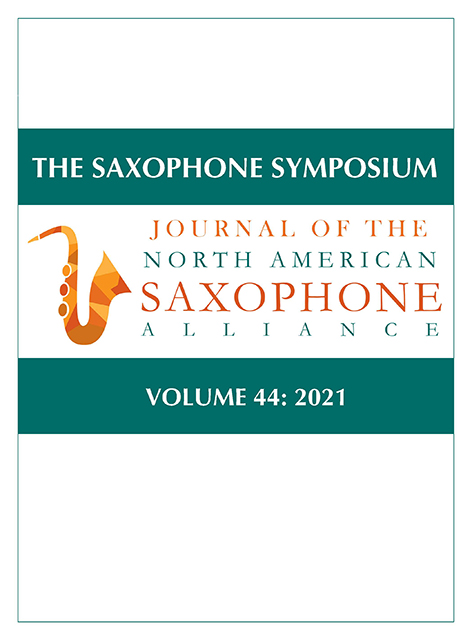Book contents
- Frontmatter
- Contents
- The Saxophone Symposium
- Nasa Executive Committee
- Notice to Contributors
- Financial Reports
- Improving the Quality of Saxophone Quartet Rehearsals: Interviews with Members of Kenari, h2, Sinta, and Fuego Quartets
- The Red Saxophone: Hanns Eisler and “Applied Music” in Weimar Berlin
- Gender Representation at North American Saxophone Alliance Biennial Conferences from 2008 through 2020
- The Raschèrian Approach: Cultivating the Elastic Bow of Articulation
- John Sampen: Biography of an American Saxophone Pioneer
- Randall Hall: Oracle
- Contributor Biographies
The Red Saxophone: Hanns Eisler and “Applied Music” in Weimar Berlin
Published online by Cambridge University Press: 14 July 2023
- Frontmatter
- Contents
- The Saxophone Symposium
- Nasa Executive Committee
- Notice to Contributors
- Financial Reports
- Improving the Quality of Saxophone Quartet Rehearsals: Interviews with Members of Kenari, h2, Sinta, and Fuego Quartets
- The Red Saxophone: Hanns Eisler and “Applied Music” in Weimar Berlin
- Gender Representation at North American Saxophone Alliance Biennial Conferences from 2008 through 2020
- The Raschèrian Approach: Cultivating the Elastic Bow of Articulation
- John Sampen: Biography of an American Saxophone Pioneer
- Randall Hall: Oracle
- Contributor Biographies
Summary
Abstract
The composer Hanns Eisler was one of the leading students of Arnold Schoenberg. Instead of taking his place alongside the likes of Berg and Webern in high-art circles, however, he turned to music driven by his leftist ideology in the late 1920s and early 1930s while living in the musical and political hotbed of Berlin. The author has identified twenty-six songs and orchestral works by Eisler that utilize the saxophone. This article will include a biography of the composer, a discussion of those works using the saxophone, and brief discussions of the use of this instrument in select pieces.
Introduction
Berlin in the 1920s and 1930s was a hotbed of activity for the saxophone. Jazz could be heard in many of the city’s nightclubs and cabarets, and this led some young composers to associate the saxophone, one of the distinctive instruments of the new art form, with modernity and progress. The activities of such composers as Paul Hindemith, Alban Berg, and Kurt Weill are well known to many saxophonists, and this atmosphere led to the development of the great saxophone pioneer Sigurd Raschèr. One prominent figure in this era has been largely neglected in American research, however: Hanns Eisler.
Eisler was prominent in his own time and was counted alongside Berg and Webern as one of Schoenberg’s favorite pupils. He continues to retain a positive reputation in Europe, including a conservatory in Berlin bearing his name. However, a holdover of Cold War politics has led to a lack of attention to this composer in the United States, despite the fact that, while he was here in the 1930s and 1940s, he garnered Academy Award nominations for his film scores and taught composition at prestigious institutions of higher learning such as UCLA and the University of Southern California. Further, for today’s saxophone community, this neglect leaves several interesting and performable pieces of chamber and orchestral music largely untouched in this country.
This paper will provide saxophonists with a biographical sketch of Hanns Eisler and will include a catalog of works by the composer that include the saxophone.
- Type
- Chapter
- Information
- The Saxophone SymposiumJournal of the North American Saxophone Alliance, pp. 16 - 32Publisher: Boydell & BrewerFirst published in: 2023

